
Entomology is the scientific study of insects, a branch of zoology. In the past the term "insect" was less specific, and historically the definition of entomology would also include the study of animals in other arthropod groups, such as arachnids, myriapods, and crustaceans. This wider meaning may still be encountered in informal use.
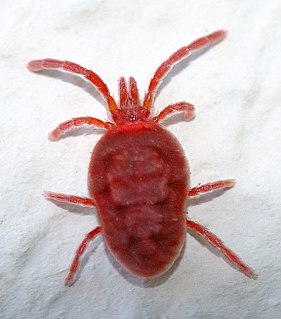
Mites are small arachnids. Mites span two large orders of arachnids, the Acariformes and the Parasitiformes, which were historically grouped together in the subclass Acari, but genetic evidence suggests are not closely related. The Parasitiformes include ticks, which are sometimes semantically distinguished from mites.

House dust mites are various species of acariform mites belonging to the family Pyroglyphidae that are found in association with dust in dwellings. They are known for causing allergies.

Spider mites are members of the Tetranychidae family, which includes about 1,200 species. They are part of the subclass Acari (mites). Spider mites generally live on the undersides of leaves of plants, where they may spin protective silk webs, and they can cause damage by puncturing the plant cells to feed. Spider mites are known to feed on several hundred species of plants.

Charles Duncan Michener was an American entomologist born in Pasadena, California. He was a leading expert on bees, his magnum opus being The Bees of the World published in 2000.
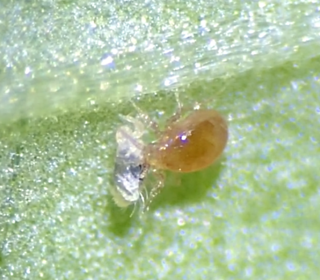
The Phytoseiidae are a family of mites which feed on thrips and other mite species. They are often used as a biological control agent for managing mite pests. Because of their usefulness as biological control agents, interest in Phytoseiidae has steadily increased over the past century. Public awareness of the biological control potential of invertebrates has been growing, though mainly in the US and Europe. In 1950, there were 34 known species. Today, there are 2,731 documented species organized in 90 genera and three subfamilies.

May Roberta Berenbaum is an American entomologist whose research focuses on the chemical interactions between herbivorous insects and their host plants, and the implications of these interactions on the organization of natural communities and the evolution of species. She is particularly interested in nectar, plant phytochemicals, honey and bees, and her research has important implications for beekeeping.

Pyemotes herfsi, also known as the oak leaf gall mite or itch mite, is an ectoparasitic mite identified in Western Canada in 1923 and subsequently found in India, Asia, and the United States. The mite parasitizes a variety of insect hosts and bites humans, causing red, itchy, and painful wheals (welts). The mites are barely visible, measuring about 0.2–0.8 millimeters; their great reproductive potential, small size, and high capacity for dispersal by wind make them difficult to control or avoid.

Trombiculidae (; commonly referred to as chiggers, but also known as berry bugs, harvest mites, bush-mites, red bugs or scrub-itch mites, are a family of mites. Chiggers are often confused with jiggers - a type of flea. Several species of Trombiculidae in their larva stage bite their animal or human host and by embedding their mouthparts into the skin cause "intense irritation" or "a wheal, usually with severe itching and dermatitis",
Trombidium auroraense is a species of mite in the genus Trombidium in the family Trombidiidae. It is found in New York, United States.
Trombidium hyperi is a species of mite in the genus Trombidium in the family Trombidiidae. It is found in New York, USA.
Varroa sensitive hygiene (VSH) is a behavioral trait of honey bees (Apis mellifera) in which bees detect and remove bee pupae that are infested by the parasitic mite Varroa destructor. V. destructor is considered to be the most dangerous pest problem for honey bees worldwide. VSH activity results in significant resistance to the mites.
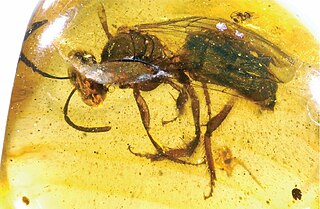
Oligochlora is an extinct genus of sweat bee in the Halictidae subfamily Halictinae. The genus currently contains six species, all of which are known from the early Miocene Burdigalian stage Dominican amber deposits on the island of Hispaniola.
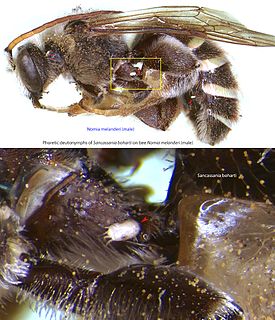
The alkali bee, Nomia melanderi, is a ground-nesting bee native to deserts and semi-arid desert basins of the western United States. It was described by Theodore Dru Alison Cockerell in 1906. While solitary, these bees nest near each other and can form extremely dense aggregations in areas with favorable conditions.

Macrochelidae is a family of mites in the order Mesostigmata, containing the following genera and species:
Laelaspoides is a genus of mites in the family Laelapidae.
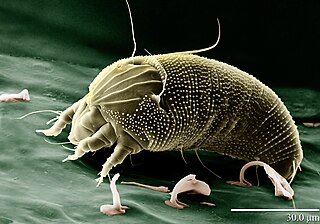
Aceria anthocoptes, also known as the russet mite, rust mite, thistle mite or the Canada thistle mite, is a species of mite that belongs to the family Eriophyidae. It was first described by Alfred Nalepa in 1892.

The Journal of the Kansas Entomological Society is a quarterly peer-reviewed scientific journal published by the Kansas Entomological Society. The journal has a 2009 impact factor of 0.607.
Marjorie Ann Hoy was an American entomologist and geneticist known for her work using integrated pest management (IPM) and biological control in agriculture. She was Professor and Eminent Scholar at the University of Florida, Fellow of the Royal Entomological Society of London, the American Association for the Advancement of Science, and Entomological Society of America. She was known as a pioneer in using genetic engineering to reduce the impact of agricultural pests, including developing pesticide resistant predators to control populations of destructive pests in areas where pesticides are applied. Her books include the textbook Insect Molecular Genetics, the third edition of which was published in 2013.

Enarthronota is a suborder of mites in the order Oribatida. There are about 14 families and more than 450 described species in Enarthronota.














